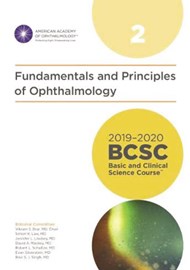The American Academy of Ophthalmology (AAO) has updated a few more books for the 2019-2020 version of their textbooks. They come with the same clean matt finish, but the colour scheme is a bright sunshine yellow instead of green. Although they’re not hardback, the covers and pages are thick and sturdy and can actually withstand getting squashed at the bottom of a backpack and even a few accidental coffee stains.
Fundamentals and Principles of Ophthalmology is split into five parts: 1. Anatomy, 2. Embryology, 3. Genetics, 4. Biochemistry and Metabolism, 5. Ocular pharmacology and Imaging. AAO always delivers great textbooks, but I have to admit I wasn’t really looking forward to reading this one. Basic science is something that is so important to know and understand but I couldn’t help but recoil at the thought of reading topics such as embryology again. I got flashbacks to studying for the part one FRCOphth and remembering just how dry all the basic science textbooks were. I tried to get some junior colleagues to review it, hoping they’d at least find it useful for exams but even they backed away in horror.
It seems that our collective reluctance was unwarranted. Compared to other ophthalmic basic science textbooks I’ve come across this was so easy to read. Virtually every page has a colourful diagram or table. It also has ‘clinical pearls’ scattered throughout it, reminding the reader why that topic is relevant to a clinician. It won’t leave you floundering or wondering which bits you should remember as it doesn’t delve into unnecessary detail. There are some great bits and pieces which I’ve kept bookmarked, such as a wonderful table summarising neuro-ophthalmic indications for imaging and the recommended imaging study.
I couldn’t help but kick myself for not picking this up when I was studying for my part 1. There are lovely summary tables (e.g. in embryology what is derived from each layer), it goes through disadvantages and advantages of different imaging modalities, the diagrams are genuinely really useful and often ones I haven’t seen anywhere else, the list goes on. It also doesn’t assume prior knowledge. So, for example, I remember trying to read about genetics back when I was a ST1. It was from a textbook that is thrown in your face if you even so much as whisper part 1 FRCOphth. I sat there and thought “crap, I need to re-revise some even more basic genetics before I tackle this chapter”. Which is the confidence boost you need before an exam, right? The AAO one is so much better. The genetics chapter is perhaps a smidge longer than what you would need for the part 1 but hey, at least you won’t want to throw it out the window.
So, in summary, if you want to tackle the basic sciences and don’t want to claw your eyes out this is the book for you. It’s a useful investment and something you can actually hang on to post exams. Enjoy.




